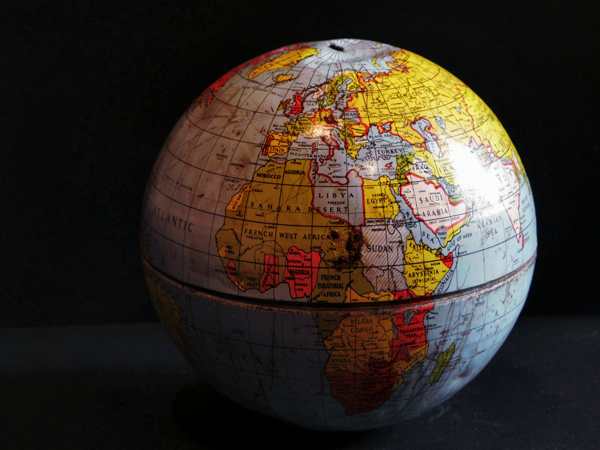Tin-plate toys were a staple of childhood for generations. Beyond just mechanical toys, tin-plate was used for a wide range of playthings, such as the tin-plate globe from the 1960s. This six-inch globe, litho-printed and made by Chad Valley, was either a birthday or Christmas present. It originally came with a stand, long since broken and lost.
The Globe and the Shape of the Earth
The word “globe” comes from the Latin word globus, meaning “sphere.” The concept that the Earth is spherical has been known since antiquity. In the 6th century BCE, Pythagoras taught that the Earth was round, and in the 5th century BCE, Parmenides built on this idea. By around 330 BCE, Aristotle had further developed the concept, providing a more scientific argument for the Earth’s shape. The Greek mathematician Eratosthenes calculated the Earth’s circumference around 240 BCE, achieving remarkable accuracy (within 2%, depending on which measure of the stadion is used).
Later, Ptolemy based his maps on a spherical Earth, and his Almagest became the authoritative work on astronomy throughout the Middle Ages. However, after the fall of Rome, Europe entered a period known as the Dark Ages—a time when intellectual pursuits declined significantly, although not as drastically as is sometimes believed.
Rediscovery and the Great Chain of Being
As learning began to re-emerge, classical texts from antiquity were rediscovered—especially in the monasteries of Ireland and through Islamic translations from the East. Scholasticism, which emerged as a dominant force in the new universities, based its teachings on the precepts of Aristotle. One of the central themes in scholasticism was the “Great Chain of Being,” a hierarchy placing everything in the universe in a strict order.
At the top of this hierarchy was God, followed by various ranks of angels. Man, created in God’s image, occupied the next position, with further distinctions between the Pope, emperors, kings, and noblemen. Humanity held dominion over animals, plants, and rocks. In keeping with Aristotle’s teachings and Ptolemy’s Almagest, the Earth was believed to be the center of the universe, with the sun, moon, and stars revolving around it, all set in concentric, rotating spheres of crystal.

The Renaissance Challenge: The Heliocentric Debate
The Renaissance sparked a rebirth of learning, prompting scholars to question the authority of ancient texts. Among the questions raised was whether the geocentric model of the universe—the belief that Earth was the center—was accurate.
Nicolaus Copernicus, a Renaissance astronomer, cautiously presented a groundbreaking idea in his work De revolutionibus orbium coelestium (On the Revolutions of the Celestial Spheres, 1543): the sun, not the Earth, could be the center of the universe. Initially, his theory faced only mild opposition. However, things took a drastic turn when Galileo Galilei openly championed heliocentrism. In 1616, he traveled to Rome to persuade the Catholic Church not to place Copernicus’s work on the Index of Forbidden Books. Despite his efforts, the Church condemned the work, and in 1633, after publishing his own Dialogue Concerning the Two Chief World Systems, Galileo was tried by the Inquisition and found “vehemently suspect of heresy.” Forced to recant his beliefs, he was sentenced to house arrest for life, and all his works were banned.
A popular legend claims that Galileo muttered, “Eppur si muove” (“And yet it moves”) after recanting. While this is likely a myth, the ban on uncensored editions of Galileo’s works and De revolutionibus remained in place until 1835.
The Flat Earth Myth: A 19th Century Fabrication
An enduring myth suggests that people in the Middle Ages believed the Earth was flat, and sailors feared sailing off the edge. However, nothing could be further from the truth. For centuries, educated people knew the Earth was round, as evidenced by Ptolemy’s maps and the calculations of scholars like Eratosthenes.
The origin of the flat Earth myth can be traced back to Washington Irving, the author of Rip Van Winkle and The Legend of Sleepy Hollow. In his 1828 biography, The History of the Life and Voyages of Christopher Columbus, Irving described Columbus facing the court of Salamanca. He portrayed Columbus as a simple sailor defying the religious authorities who supposedly opposed his voyage, claiming it was against ecclesiastical law to believe in the existence of antipodes (the other side of the Earth). Irving’s account was a mix of fact and fiction, and this was certainly fiction. The true opposition Columbus faced came from his miscalculation of the Earth’s circumference, not disbelief in its spherical shape.
Nevertheless, Irving’s narrative became a popular depiction of the Catholic Church as ignorant and dogmatic, a view that gained traction during the 19th century as science and religion were increasingly seen in opposition.

Science vs. Religion: The Legacy of Conflict
The supposed antagonism between science and religion gained ground throughout the 19th century. Examples like Irving’s served to fuel the narrative that religion was irrational. One notable publication that solidified this view was John William Draper’s History of the Conflict between Religion and Science (1874). Draper’s book argued that science represented progress and intellectual freedom, while religion symbolized superstition and repression. Draper’s work, which was printed fifty times in fifty years, reinforced the myth that people in the Middle Ages believed in a flat Earth and depicted science and religion as irreconcilable foes.
Ironically, Draper himself became part of another historical debate on evolution. In 1860, Draper delivered a lecture in Oxford entitled “On the Intellectual Development of Europe,” in which he discussed Charles Darwin’s theories of evolution. The lecture itself was deemed too long and tedious, but the subsequent discussion became famous for an exchange between Bishop Samuel Wilberforce and scientist Thomas Huxley. When Wilberforce sarcastically asked Huxley whether he claimed his descent from a monkey through his grandmother or grandfather, Huxley reportedly replied that he would rather have a monkey for an ancestor than be connected with a man who used his talents to obscure the truth.
The Evolution Debate Continues
The debate over evolution, which might have seemed resolved long ago, still rages today. In the U.S., the term “Darwinian” is often used with negative connotations, while in the U.K., Charles Darwin is celebrated to the extent of being featured on the ten-pound note.
Conclusion: Myths, Misconceptions, and Learning
As the myths about the shape of the Earth and the supposed conflict between science and religion show, understanding history requires critical thinking. It is easy to see how popular narratives, misconceptions, and the retelling of events can distort reality. As science and history evolve, it’s important to question, explore, and challenge these myths to uncover the true stories that shape our understanding of the world.

